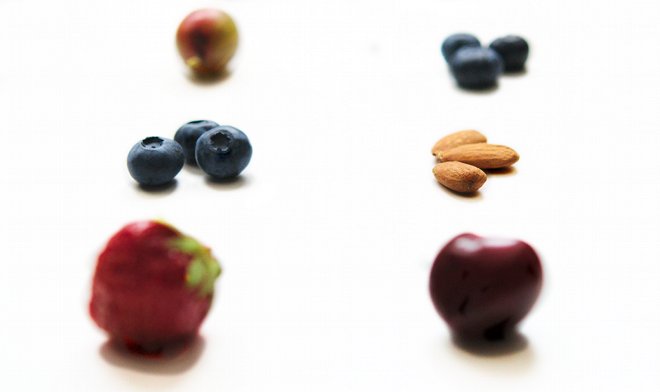
With summer gone, it is time to preserve the last fresh fruits for winter. The last part of the Cherry, berry, nut series will present three more unusual jams, all made from fruit available at this time of the year. While they may not seem as adventurous as the earlier rose petal and shallot jams, they all have a little extra which gives them a more interesting taste than the traditional fruit-boiled-with-sugar. Whether you use them as a homemade gift, or to brighten your own winter days with some fruit taste, they are a delicious treat worth making.
The ideas in the three recipes are not unique to autumn fruit. All three of them – adding nuts to the jam, making a freezer jam, and making a spicy jelly – can be applied to other types of fruit too, depending on what is in season.
Jam with nuts
There aren’t many ways to add to the texture of preserved fruit. You are basically choosing between jam (a homogenous puree), jelly (juice stiffened to wobbliness) and preserves (pieces of cook-softened fruit embedded in one of the above, or in sugar syrup). If you want something with more bite than cooked fruit, the solution is to use nuts. They won’t stay crispy and crunchy, but their firmness still provides a good counterpoint to the soft jam, and the flavor they bring enriches the already tasty fruit.
You can enhance most jam recipes by adding nuts to them, just pay attention to select compatible tastes. It is always easy to choose classic combinations, for example papaya-pineapple-coconut. But some unusual mixes also provide a very tasty discovery. In the short time pomelos are available in supermarkets here, I always make a pomelo-kiwi-almond marmalade. Today’s jam offers a blend of autumn flavors – cranberry and pear, slightly accented by cinnamon, rounded off with the mild almonds.
Pear-cranberry-almond jam
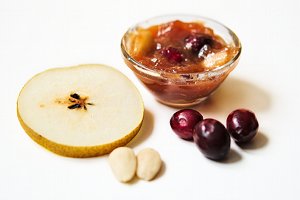
- 50 g almonds, blanched and peeled
- 500 g ripe pears
- 100 g fresh cranberries or 30 g candied cranberries
- 25 ml apple juice
- 15 ml lemon juice
- 350 g sugar
- 3 g ground cinnamon
- pectin
Peel and core the pears. Cook them with the apple juice and lemon juice until soft. Puree them, add the remaining ingredients and cook until the cranberries split. If using candied cranberries, cook until the jam gels.
Freezer jam
If you never had freezer jam, you might wonder why somebody would waste freezer space on a food which can be stored in the pantry. The problem is that you have to sterilize jam before storing it in the pantry, thereby cooking the fruit. If you want to enjoy the authentic, fresh taste of the fruit, you have to store uncooked jam in the freezer.
As most other jams, freezer jam works with a variety of fruits. It is best for fruit which changes its taste a lot when cooked (for example, strawberry freezer jam tastes very different from cooked strawberry jam; for even better taste, try strawberry-blackberry freezer jam), or generally for very fresh tastes. The tanginess of the lime in a kiwi-daiquiri jam is much better fresh than cooked. The recipe in today’s post is an example of the former: melon is a fruit whose aroma breaks down quickly under heat, so the mango-melon jam is a prime candidate for freezing.
The recipe as described below should be made with HM pectin, and even then it doesn’t set as hard as usual, because pectin needs some heating to set well. If you prefer a firmer jam, or are using LM pectin, you should first simmer your pectin in a few tablespoons of water or fruit juice and then quickly stir in the hot pectin into the room-temperature jam.
Melon-mango freezer jam
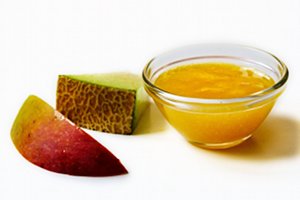
- 200 g mango flesh (ca. 1 big mango)
- 200 g honeydew melon flesh
- 200 g sugar
- 20 ml lemon juice
- a pinch of fresh grated ginger
- pectin
Puree the fruit flesh with the lemon juice. Mix the pectin into the sugar. Stir the sugar-pectin mix and the grated ginger into the fruit puree, pour into jars leaving some headroom for expansion and let it stay in the fridge for 3-4 hours, until set. Then move to the freezer for storage.
Spicy jelly
The combination of spicy and sweet is not for everybody, but it still has ardent fans. Aside from classics like dark chocolate with chile, spicyness combines well with many types of fruit. It is important to remember that your goal is not to make your mouth feel aflame, but to add a new sensation without masking the existing taste of the fruit. Chiles are seldom added to jams, instead they are used to infuse fruit juice which is then processed into jelly or marmalade.
You can combine hot chiles with either fruit (spicy strawberry jelly) or vegetables (spricy green pepper jelly). There is even spicy wine jelly, made with white wine and thyme. Today’s recipe is for an orange marmalade, where the strong flavor holds up well to the hotness of the chile.
I am intentionally vague on the subject of chile peppers in the recipe; the variety and amount you choose will depend on how spicy you want the jelly to be. I would advise you to err on the sweet side, and re-simmer your juice with more peppers if it is not spicy enough for you.
Sharp orange marmalade

- 1 kg oranges
- 100 ml orange juice
- 1-3 chile peppers
- 250 g sugar
- 15 ml lemon juice
- pectin
Cut the chiles to rings, add them to the orange juice and simmer for 10 minutes. Strain the result and throw the chiles away.
Use a grater or a potato peeler to create thick strips of orange peel. Juice the oranges. Mix the chile-infused juice, the fresh juice, the zest strips, the lemon juice and the sugar and bring to a boil. Add the pectin and cook until gelled.
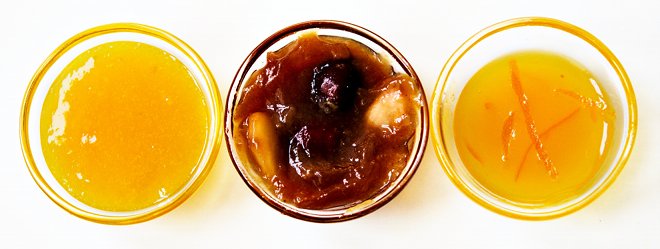
From left to right: Mango-melon freezer jam, pear-cranberry-almond jam, sharp orange marmalade
This post concludes the series on jams and preserves. In a total of four parts, I have shown 11 ways to make jams different. I hope you found them a useful inspiration for your own jam experiments. And if some winter day the cold and the wetness seem to freeze you to the bones, go to your pantry and open a jar of those preserves – they can cheer you up from the dreariest winter depression.
Notes
- Not all jams in this series are certain to have the needed acidity for hot water canning! Measure their pH and if it is above 4.5, you can either use pressure canning or keep them in the fridge. For more information on food safety and canning, see this official information on canning safety
- I intentionally didn’t include pectin amounts in the recipes. The amount of pectin you use is dependent on the type and brand of pectin you buy. Use the guidelines printed on your pectin package, or learn more about pectin.
- If you want a small primer on the difference between jam, jelly and preserves, The Kitchn has a great article.
- If you missed the previous posts of the series, they are here, here and here.
Filed under desserts

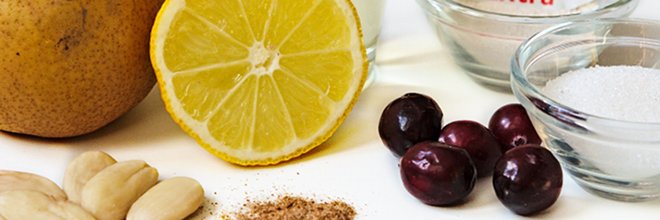


Subscribe to comments with RSS.
Comments have been closed for this post